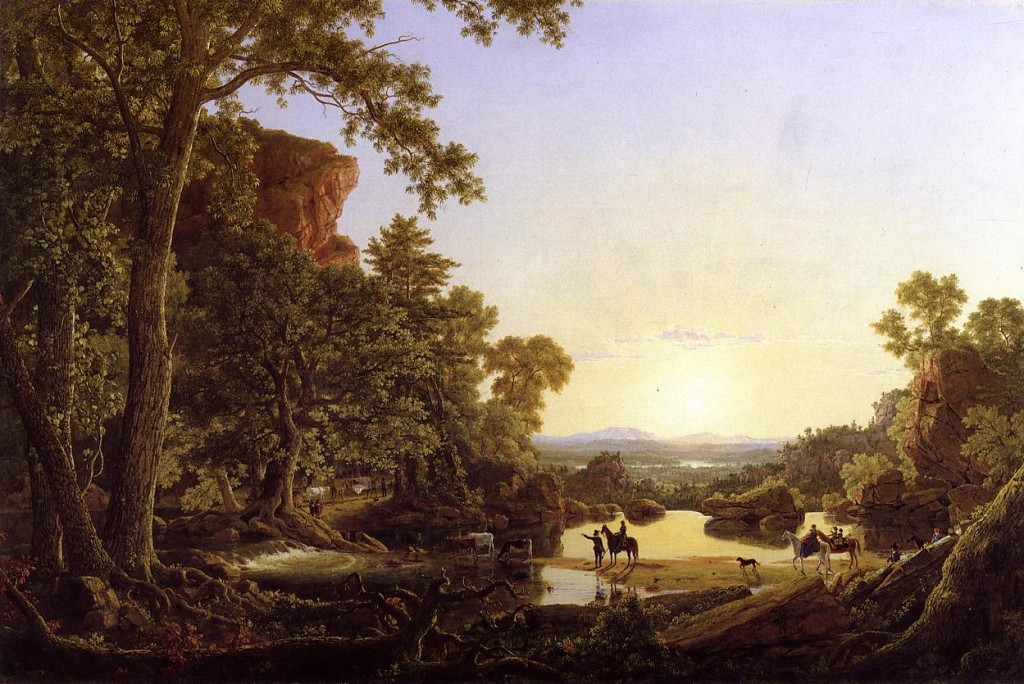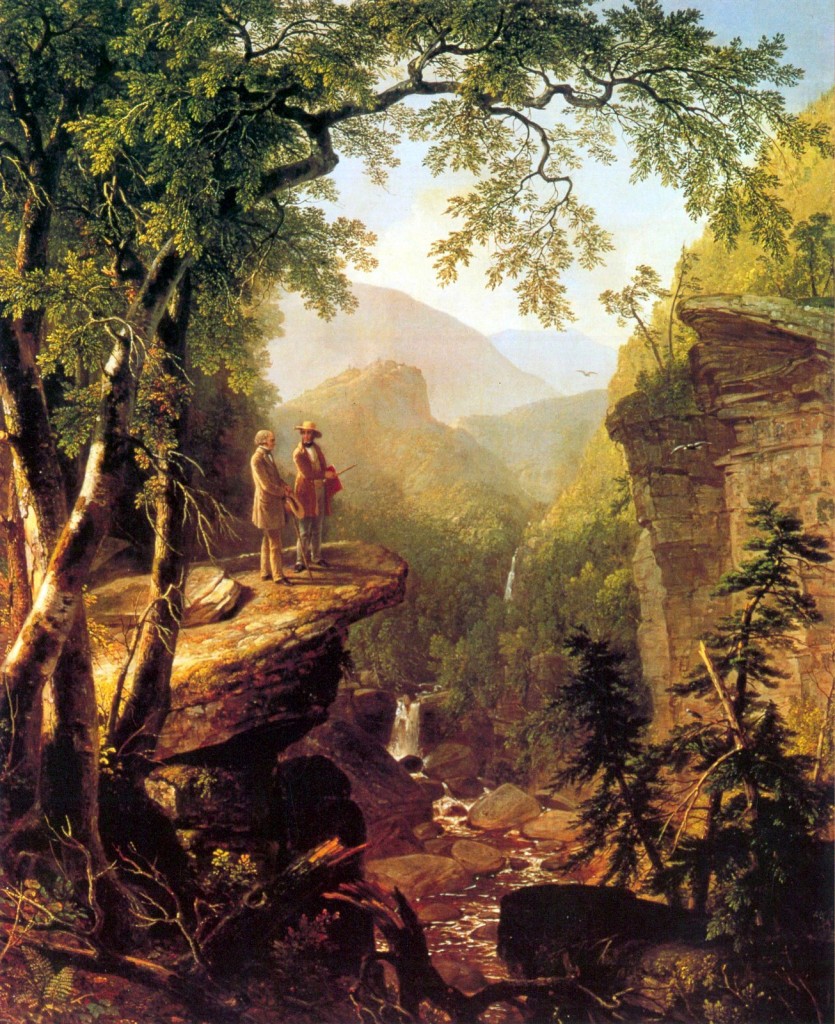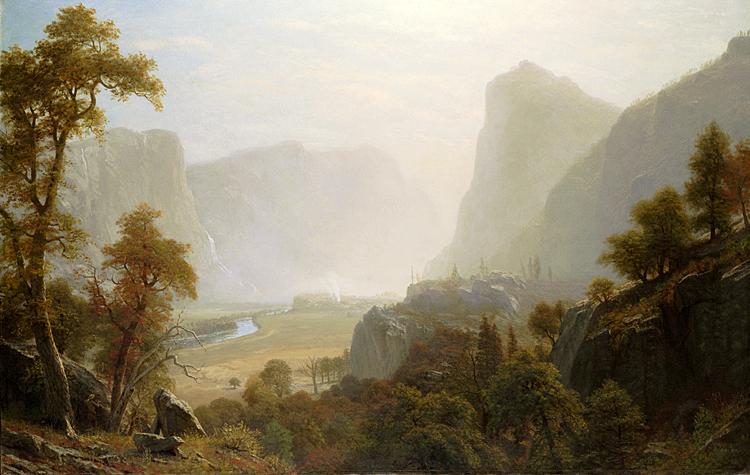Decode: Some paintings and a bit of analysis
View in the White Mountains, 1827: Thomas Cole
Thomas Cole is perhaps the most well-known of all the Hudson River School artists. His notoriety derives from both his awe-inspiring european romanticism in his narrative pieces and, more importantly, for his role in establishing this American style of art; one in which the beautiful and the sublime are interwoven. In his painting pictured above, Cole does just that.
Take a look at the painting and explore as you like. Click the painting for a high-resolution image.
You, or the average viewer, looks at this painting and is drawn down the dirt road in the foreground before the road disappears into the space between the foreground and middle-ground, and your gaze is drawn across the valley. Your eyes follow the lines of the river and the light before they are led up the side of Mt. Washington. While your eyes jump from the snow atop the mountain peak to the white clouds, they will inevitably be drawn down to the landscape by the detail, leading lines, and Raphael-esque light and color of the large tree in the foreground. If not, they are drawn down the gently slopping mountain sides, which frame the whole scene and conveniently intersect at the end of the road. The three settlers on that road help your eyes understand receding space within the painting.
In the foreground, the man closest to the viewer walks towards the large tree with an ax and a basket. A fallen branch from this very tree lays across the road hindering this man’s metaphorical progress forward. Behind the man, further down the road, are blasted tree trunks, which is a stylistic element that is characteristic of Cole’s work. They stand as a symbol of the untamed power of nature. This tree, like the unexplored American territories, could arguably stand to represent the wild and un-civilized landscape. The road, with its cart-track puddles touched by water from a recent storm, stands to more or less represent society’s duty to cultivate that land.
Cole painted this piece while journeying to the White Mountains in New Hampshire with his friend and patron William Wadsworth. The artist’s use of light to create atmosphere, composition, choice of warm yellows, greens and blues, along with the aforementioned symbolic elements, combine to evoke the beautiful and the sublime.
Hooker and Company Journeying Through the Wilderness from Plymouth to Hartford, 1846: Frederic Church
As Cole’s only student, Frederic Church largely followed in his footsteps with regards to his general style and use of allegorical references. Although Church was born in Connecticut and spent a serious portion of his life traveling throughout Europe and Latin America, Church will forever be associated with the Hudson River School’s style of landscape painting as he was a leading second generation member. Church is famous for his ability to portray human, spiritual and natural drama in large-scale pieces of art. His use of Claudian conventions and Titian-esque detail alongside his rough and dark wilderness is emblematic of the school’s style.
In the painting shown above, Church depicts a historical narrative in this landscape scene. In the middle-ground of the painting, Thomas Hooker, a free-thinking Puritan who led his followers through the Massachusetts and Connecticut wilderness in order to establish a colony free from religious persecution, is directing his followers leftward towards the “Charter Oak” (a reference to the first arrival of Pilgrims). The leftward facing composition, according to Art Historian Roger Aikin, “reflects or reinforces the westward historical, political, psychological orientation of the nation during the era of Manifest Destiny. In other words, these paintings are intended to be read as maps.” Understood as such, Hooker and his followers indicate a general movement to the West. Just as Hooker and his followers went into the physical space to expand their personal liberties, so did the philosophers, artists and travelers who expanded the known American territory. In the “American experience,” as best pictured here, the human and spiritual drama defines the landscape.
Church’s excellence in portraying light and creating a line-to-focal point connection entraps the viewer into an aesthetically pleasing painting. The deep shades of color and darkness in the foreground in this painting, along with the pastel shades of color and bright light in the background are not coincidental; Church wanted to impart the viewer with a connection between God and nature, a connection between light and nature. One could even make the claim that Church tries to evoke the birth of Christ, in his depiction of Hooker and his followers.This painting was purchased after completion by patron and art collector, William Wadsworth, almost immediately after it went for sale.
Kindred Spirits, 1849: Asher Durand
Kindred Spirits, the title of this piece, is a nod to the legacy of Thomas Cole, and his friendship with poet William Bryant. The are both pictured in the middle-ground. Jonathan Sturges, patron and wealthy merchant, commissioned the piece shortly after Cole died during the extremely cold winter of 1848. As mentioned earlier, Cole is revered now as he was then for his artistic mastery. As such, many fellow artists, his one student – Church, and the rest of the surrounding art world mourned his passing. Cole, in short, was the god-father figure of this school. Church’s piece, To the Memory of Cole, is another heartfelt dedication to Cole, his mentor. Sturges gave Bryant this piece as a gesture of thanks for delivering such a touching eulogy at Cole’s funeral.
Cole (right) and Bryant (left) stand in the left middle ground of the painting. Bryant holds a walking stick and Cole carries a sketchbook and flute; a reference to his love of art and music. If you in any way doubt the identity of the persons in this piece, please zoom into the white birch of the closest tree on the left and there you will find both of their names carved into the tree. In addition, Durand added Cole-esqe painterly attributes to the piece in his honor, such as the blasted tree trunks in the foreground, which is emblematic of Cole’s work.
The background landscape, what Cole and Bryant are admiring, is not a view one could see in reality because it is a composite landscape of different vistas that Cole either frequented or captured. At the forefront of the background layer of this piece sits Fawn’s Leap, which was once a popular hiking destination and has its place in local folklore. Above Fawn’s Leap and slightly to the right you can see Kaaterskill Falls, a magnificent waterfall, which, at the time, was more or less, untouched by human influence. Behind this waterfall Durand has painted the Catskill Mountains. Please Click Here! for the corresponding virtual tour for more information about these sites.
Durand’s own painterly style does come through in this piece despite his effort to paint in a Cole-esqe manner. His attention to detail in the foreground, specifically the leaves and bark of the trees, the crevasses’ in the rocks and the tone of the water are all emblematic of Durand’s quality.
The Hetch-Hetchy Valley, 1874-1880: Albert Bierstadt
Albert Bierstadt was a second-generation painter associated with this school who is famous for his awe-inspiring panoramas of the American West, a region he thoroughly explored on a journey that lasted five years. Bierstadt was born in Germany and came to the United States at a very young age. He later returned to Germany to study painting a few times. Bierstadt’s style is akin to the characteristic Hudson River School style; warm colors, luminist light, cragged wilderness, inviting plains and mysterious native elements. Yet, there is something captivatingly distinct in his gargantuan sized pieces that are filled with delicate detail and poetic symmetry.
Take a look at the painting. Please click it for an enlarged version.
You, the viewer, are looking at the once-real Hetch-Hetchy Valley in Yosemite on the Tuolumme River in California. This valley no longer exists because it was damned, years ago, into a nine-mile reservoir that supports San Francisco’s ever-increasing population. Bierstadt traveled here during the aforementioned journey; he went looking for a ‘new Yosemite,’ as he referred to it. He felt as if he needed a new natural wonder to inspire him and entrance potential buyers. Artists were moving west, and the number of yet-to-be captured, natural wonders in the landscape was rapidly diminishing.
In the above piece, Bierstadt has used warm reds, greens and yellows to underscore the high-keyed autumnal foliage. These strokes are simultaneously contrasted and complimented by the warm pastels, which meet in the right middle-ground to form a luminist-like characteristic. The painting is more or less divided into three layers. In the foreground, one can see the detailed foliage and an individual peering into the middle-ground, who we can assume is the painter himself, leaning up against a boulder behind a tree on the left. In the middle-ground, your eyes are drawn to the hazily lit plain and the winding river, which lead your eyes to the distant smoke billowing from what is most likely a Native American camp. From there, one’s eyes are drawn up the jagged left side of the mountain before spiraling off into the pink, blue and white haze of the sky. Bierstadt’s attention to detail (note the Raphael-esque detail in the foreground) on such a large scale in his was unmatched at the time by none other than his rival, Church. For more on their rivalry, please view the school and its students tab.




